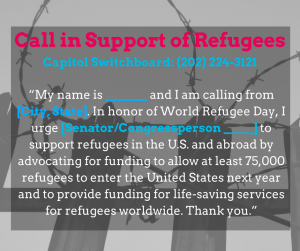Around the world, there are 65.3 million people who have been forced out of their homes, over half of them under the age of 18. According to the Center for American Progress, 21.3 million of these people are externally displaced and seeking refuge in a different country – the rest are internally displaced in their country of origin. Today, the world is facing the largest humanitarian crisis in human history. Refugees come from all over the world, from Syria to Somalia, Afghanistan to Colombia, and Burma to Iraq. In the U.S., the highest number of refugees come from the Democratic Republic of the Congo, one of STAND’s core focus areas. There is no single kind of refugee, but all are facing strife and deserve our help and compassion.
June 20 is a day to come together and commemorate the strength and resilience that refugees possess and continue to exhibit despite the hindrances in their lives. On December 4, 2000, the UN named June 20 World Refugee Day in celebration of the fiftieth anniversary of the 1951 UN Convention Relating to the Status of Refugees.
The 1951 Convention not only defined the term “refugee”, but also outlined the rights of displaced people and the legal obligations of states to protect those displaced by conflict. The UN High Commission for Refugees (UNHCR) serves as the institution that defends these protocols and guidelines, protecting and aiding refugees at the request of governments and the UN, and assisting in voluntary repatriation and resettlement efforts for refugee populations around the world.
Although today is called World Refugee Day, there are varying terms to describe displaced people. The Canadian organization Humanitarian Coalition defines a refugee as a person who is outside their country of nationality “owing to a well-rounded fear of being persecuted.” Once deemed a refugee, a person is entitled to the protections outlined in the Refugee Convention, including international protection and assistance. Despite that presumed security, there are many pitfalls and flaws that vary country to country, depending on inequities among refugees from different nationalities, outdated qualities of the 1951 Convention, and the evident struggles of simply moving to a new country with the ‘refugee’ stigma. An internally displaced person (often called IDP for short) is someone who has fled their home but has not left their country of origin. In 2015, there were around 38.2 million people who, after being forced out of their homes, met this definition. Asylum seekers are individuals who are seeking protection as a refugee but have not yet been legally granted refugee status. Without refugee-specific protections, they may be forced to return to their country, where persecution awaits them. Finally, stateless people are those who are not considered nationals of any state. The UNHCR estimates about 10 million people worldwide are stateless due to discrimination by other groups, flaws in nationality laws, and differences in country borders.
Last year, the United Nations created a #WithRefugees petition to garner support of refugees and encourage governments to do their part in protecting and assisting our world’s refugees. As European countries and other states such as Lebanon, Jordan, and Turkey are inundated with refugees they do not have the capacity to fully support, we call on other governments, such as the United States, to do their part to alleviate the crisis – by supporting refugees in the region, accepting more refugees into the U.S., and by investing in conflict mitigation and prevention efforts to prevent future refugee crises from occurring.
Here are three ways you can take action for World Refugee Day:
- Sign the #WithRefugees petition.
- Call your Senators and Representatives and express the need for them to support U.S. refugee resettlement.

- Attend an event near you! Look at this map to find your closest community event.
In order to send a message to the Trump Administration that we, as Americans, support refugees and resettlement programs in the U.S., we are co-sponsoring a rally at the White House today. Our message is clear – “No hate. No fear. Refugees are welcome here.” By standing with a variety of allies, from faith communities to business leaders, advocacy groups to individual committed citizens, we will urge the President and Congress to commit to resettling 75,000 refugees in 2018. Please join us, or participate in an event near you, to stand with our refugees and make a message.
–
 Ashley Morefield is a rising senior at Dickinson College in Carlisle, Pennsylvania. She majors in International Studies with a concentration in Sub-Saharan Africa and French & Francophone Studies. After spending a year studying abroad in Toulouse, France, she’s excited to intern at STAND’s office in Washington, D.C. this summer.
Ashley Morefield is a rising senior at Dickinson College in Carlisle, Pennsylvania. She majors in International Studies with a concentration in Sub-Saharan Africa and French & Francophone Studies. After spending a year studying abroad in Toulouse, France, she’s excited to intern at STAND’s office in Washington, D.C. this summer.
Featured Image: (c) Wikipedia. 2013.


 Ashley Morefield
Ashley Morefield